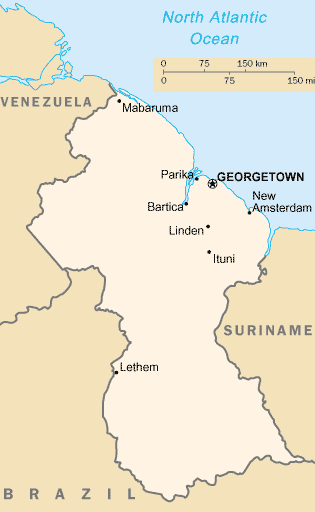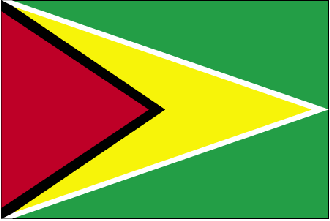
|

Guyana
Background:
Originally a Dutch colony in the 17th century, by 1815 Guyana had become a
British possession. The abolition of slavery led to black settlement of urban
areas and the importation of indentured servants from India to work the sugar
plantations. This ethnocultural divide has persisted and has led to turbulent
politics. Guyana achieved independence from the UK in 1966, but until the early
1990s it was ruled mostly by socialist-oriented governments. In 1992, Cheddi
Jagan was elected president, in what is considered the country's first free and
fair election since independence. Upon his death five years later, he was
succeeded by his wife Janet, who resigned in 1999 due to poor health. Her
successor, Bharrat Jagdeo, was reelected in 2001.
Location:
Location: Northern South America, bordering the North Atlantic Ocean, between
Suriname and Venezuela.
Area: Total: 214,970 sq km, water: 18,120 sq km. land: 196,850 sq km.
Area - comparative: Slightly smaller than Idaho.
Land boundaries: Total: 2,462 km, border countries: Brazil 1,119 km, Suriname
600 km, Venezuela 743 km.
Coastline: 459 km.
Climate and Terrain:
Climate: Tropical; hot, humid, moderated by northeast trade winds; two rainy
seasons (May to mid-August, mid-November to mid-January).
Terrain: Mostly rolling highlands; low coastal plain; savanna in south.
Elevation extremes: lowest point: Atlantic Ocean 0 m highest point: Mount
Roraima 2,835 m
Natural resources: Bauxite, gold, diamonds, hardwood timber, shrimp, fish.
People:
Population: 702,100.
Ethnic groups: East Indian 50%, black 36%, Amerindian 7%, white, Chinese, and
mixed 7%.
Religions: Christian 50%, Hindu 35%, Muslim 10%, other 5%.
Languages: English, Amerindian dialects, Creole, Hindi, Urdu.
Government:
Government type: Republic within the Commonwealth.
Capital: Georgetown.
Economy overview:
The Guyanese economy has exhibited moderate economic growth in 2001-02, based
on expansion in the agricultural and mining sectors, a more favorable
atmosphere for business initiatives, a more realistic exchange rate, fairly low
inflation, and the continued support of international organizations. Chronic
problems include a shortage of skilled labor and a deficient infrastructure.
The government is juggling a sizable external debt against the urgent need for
expanded public investment. The bauxite mining sector should benefit in the
near term by restructuring and partial privatization.
Statistics:
Telephones - main lines in use: 70,000.
Telephones - mobile cellular: 6,100.
Radio broadcast stations: AM 3, FM 3, shortwave 1.
Radios: 420,000.
Television broadcast stations: 3 (one public station; two private stations
which relay US satellite services).
Televisions: 46,000.
Internet users: 95,000.
Railways: total: 187 km.
Highways: Total: 7,970 km, paved: 590 km, unpaved: 7,380 km,
Airports - with paved runways: 8,
with unpaved runways: 43.
Return to Visiting Locations
|

